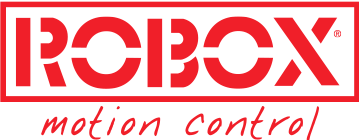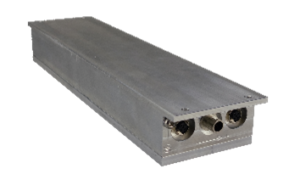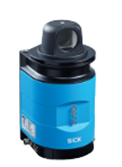Robox has been involved in the navigation of autonomous vehicles since 1992.
The first technology to be adopted was Guide by Wire, and involved the usage of buried wires that were detected by magnetic antennas located underneath the vehicles. Alongside magnetic tape, this system has been the lead navigation technology for decades.
Although the system was very reliable, it had several drawbacks, the main one being represented by the difficulty of laying the wire around curved paths.
To this problem Robox responded by interrupting the wire along corners navigating the vehicle through odometry measured by the wheels actuators. This system was later equipped with a gyroscope to increase overall reliability. This set the ground for the birth of a new navigating system that would lead to a new era of autonomous navigation.
IGV
Inertial Guided Vehicles (IGV) navigate the environment through a combination of odometry, gyroscope and magnets. In this system the wire has been replaced by cylindrical magnets, that are strategically disposed along the path of the vehicle.
The most used magnets are 10mm in diameter and 40mm long and are usually installed every 5 meters, this changes according to the properties of the plant, however.
This system is far less intrusive for the plant floor and permits positioning of the vehicle with millimetric precision. Buried magnets are extremely resilient to external solicitations, resist aggressive cleaning of the pavement, passage of vehicles and can be localized by the vehicles even when covered by debris or metal dust. This makes IGVs extremely suitable for light and heavy production environments, warehouses and most other applications.
Other navigation Methods
Alongside Inertial Magnetic Navigation, Robox offers laser triangulation and natural guidance (SLAM) which are discussed in the hardware section further below.
Navigation Hardware
Magnetic Antenna
Magnetic Antennas come both in rectangula and quare shape, while rectanglar antennas are suitable for longitudinal navigation square antennas are recommended for omnidirectional vehicles. Some vehicles might require the installation of multiple antennas to provide higher precision and reliability.
Since the antenna is installed underneath the vehicle, and no further positioning system is required, the system allows “turtle vehicle” (low profile) configurations.
Advantages:
- Simplicity of the necessary infrastructure, especially when compared to laser systems that require precise mirror placement.
- Resistence and adaptiveness to environment changes. The system only relies on the ground magnetic flux reading, changes in environment, renewal of pavement paint or resin, changes in environment light intensity do not affect the navigation system of the vehicle.
- High positioning precision. By strategically placing the magnets it is possible to achieve higher positioning precision where required while mantaining the installation simplicity of the plant.
- Possibility to work with “turtle vehicles” thanks for the absence of components that require visibility clearance in the system.
- Easy and reliable outdoor navigation.
Disadvantages:
- Necessity of precise magnet installation.
- Necessity to install new magnets when configuring new routes.
- Relative rigidity in route modifications.
ROKIT
Rexroth Rokit is used by robox for SLAM navigation, this method uses Proximity Laser Scanners (PLS) to navigate the environment using specific hardware and software that provides a reference for the vehicle position in space.
Advantages:
- Flexibility in defining and modifying routes.
- Possibility of configuring “turtle vehicles” thanks to the low position of PLS devices.
Disadvantages:
- Low tolerance to environmental variation. Excessive environment modification can lead to the incapability of determining the vehicle position.
- Unreliability in open spaces. The system requires the presence of static objects, such as walls or pillars, to determine the position of the vehicle.
- Limited positioning precision, especially in absence of static reference objects.
- Requires the installation of known markers to achieve precision and reliability in some environments.
- Susceptibility from intense incident artificial or natural light.
NAV350
Sick Nav350 is used by Robox to navigate vehicles using laser positioning system. This positioning method uses fixed mirrors to reflect the laser beam emitted by the positioning device obtaining the absolute position of the vehicle by triangulating the mirror positions.
Advantages:
- Ease and flexibility in route definition.
- Relative simplicity in the necessary infrastructure (passive mirrors), but more complex when compared to placing magnets.
Disadvantages:
- Very stringent requirements on floor evenness and flatness.
- Necessity of an installation pole that forbids the usage on “turtle vehicles”
- Difficulty in outdoor installation.
- Susceptibility from intense incident artificial or natural light.
- Difficulty in navigating warehouse corridors.
Control Hardware
Alongside the navigation hardware, control hardware is required to control the vehicle means of motion, auxiliary axes and to compute the mathematics of the navigation. This is handled by Robox motion controller RP-2. After being equipped with AGV Specific software, the device also manages communication with Robox AGV Manager and controls the robotic systems of the vehicle.
The software running on the vehicle receives commands from the AGV Manager that are either generic, such as common navigation commands, or plant specific. Specific commands define special routines that are designed around the plant needs and can control both the vehicle, the auxiliary axes and the possible robotic systems installed on the AGV.
Map Description Software
Robox AGV Tool (RAT) is used to map the plant, define the lines, stations, magnet positions and semaphores. RAT is also used to parametrize the behavior of the vehicles around corners, the speed limit on the lines, and the navigation direction of the vehicle for omnidirectional vehicles.
Alongside magnet position RAT can manage the position of the mirrors used for laser guidance and import the plant layout file file (DXF format) provided by natural guidance systems. RAT is also capable of simulating traffic and vehicle behavior to help the operator optimize the performance of the plant.
AGV Manager
The control of the AGV fleet is provided by AGV Manager, a simplified development environment that offers an intuitive UI showing the plant in operation, and offers different password protected levels of access.
AGV Manager is usually interfaced with the existing management software and produces the instructions that drive the single vehicles. In its operation it prevents collisions, deadlocks and optimizes the movement of the AGVs to evade the maximum amount of missions in the shortest possible time.
AGV Manager is also used to program the behavior of the plant using X-Script, a simplified programming language with a dedicated api to control the flow of the operations on the plant. AGV Manager can also be interfaced with an external PLC to control the static infrastructure, such as automatic gates, safety devices and other specific needs of the plant.
This post is also available in: Italian



